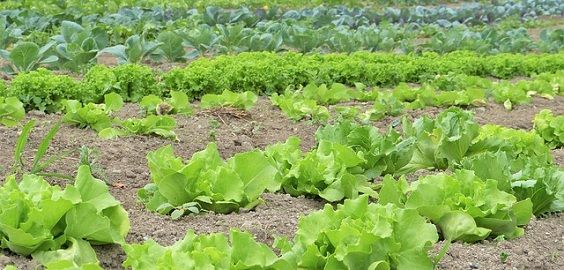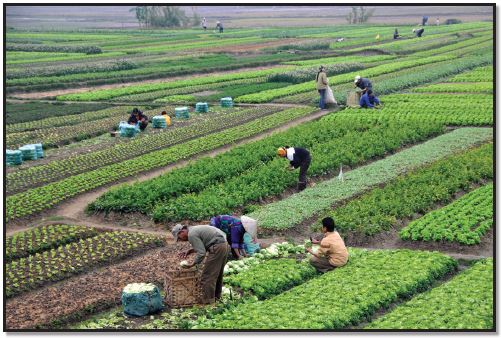Comprehending the Impact of Chemical-free Farming on Environmental Health
The exploration of organic farming's influence on environmental health presents an engaging story of environmental equilibrium and sustainability. By focusing on natural processes over artificial treatments, organic farming practices provide an encouraging option to some of the most pressing environmental difficulties.
Enhancing Dirt Fertility
Enhancing soil fertility is a cornerstone of natural farming, as it directly impacts crop yield and ecological sustainability. Organic methods prioritize the all-natural enrichment of soil wellness, mostly with making use of raw material such as compost, environment-friendly manure, and cover plants. These techniques improve dirt structure, water retention, and nutrient availability, fostering a growing ecological community of bacteria and useful insects that add to soil wellness.
Organic farming eschews synthetic plant foods, deciding rather for natural modifications that promote well balanced nutrient cycling. This method not only restores necessary nutrients like potassium, phosphorus, and nitrogen however also boosts the soil's ability to sequester carbon, minimizing climate adjustment impacts. The integration of plant turning and polyculture practices additionally contributes to soil fertility by protecting against nutrition deficiency and reducing pest pressure.
Moreover, the emphasis on keeping living origins year-round via cover cropping helps lower soil disintegration and advertise biodiversity. This biological diversity is vital for sustainable farming, as it supports resilience against bugs and diseases. In summary, organic farming's emphasis on boosting soil fertility not only enhances productivity yet also lines up with wider ecological goals, guaranteeing long-lasting farming stability and eco-friendly balance.
Minimizing Pollution
Mitigating air pollution is a fundamental facet of chemical-free farming, which stresses lasting agricultural practices that decrease environmental effect. By eschewing artificial fertilizers and chemicals, natural farming substantially minimizes the leaching of dangerous chemicals right into soil and water systems. This technique not just safeguards aquatic ecological communities but likewise ensures the pureness of groundwater, a crucial source for animal and human consumption. Natural farming's reliance on all-natural plant foods, such as compost and environment-friendly manure, more boosts dirt health without presenting pollutants.
Furthermore, organic farming approaches contribute to air high quality improvement. Organic farming frequently entails crop turning and cover chopping, practices that improve carbon sequestration and lower greenhouse gas emissions.
Additionally, organic accreditation criteria enforce stringent standards on waste management, making certain that farming deposits are handled in an ecologically liable fashion. These procedures jointly decrease the air pollution burden on the atmosphere, advertising a cleaner, healthier community. Therefore, natural farming plays a pivotal role in curbing air pollution and cultivating lasting farming landscapes.
Supporting Biodiversity
Invariably, natural farming plays an important function in promoting biodiversity by promoting a diverse environment within agricultural landscapes. This method accepts natural processes, avoiding synthetic chemicals and genetically customized microorganisms, which can interrupt regional plants and fauna. By utilizing crop rotation, polyculture, and the upkeep of all-natural environments, natural farming supports a range of species, from dirt bacteria to pollinators and predators that normally control bug populations.
One of the key facets of natural farming that enhances biodiversity is the emphasis on keeping and boosting dirt health. Healthy dirts function as habitats for a wide range of organisms, adding to vitamins and mineral cycling and ecosystem strength. The evasion of synthetic pesticides and fertilizers reduces damaging runoff, shielding nearby communities and water bodies from contamination, which often causes a richer biodiversity in bordering areas.
Additionally, organic farms often integrate barrier zones, hedges, and cover plants, which provide additional habitats and food resources for wild animals. These attributes develop passages for pet motion and rise hereditary diversity within populaces. By promoting eco-friendly balance and durability, natural farming helps sustain different life forms, inevitably adding to the stability and efficiency of farming systems and the more comprehensive environment.
Conserving Water Resources
Organic farming significantly contributes Read Full Article to the preservation of water sources via lasting practices that improve water effectiveness and lower contamination. By emphasizing soil health and wellness, organic farming boosts the soil's ability to keep wetness, therefore lowering the need for extreme watering. Methods Source such as plant turning, cover chopping, and the use of raw material improve the dirt framework, raising its water retention ability. This approach not just saves water but likewise makes sure the durability of plants throughout durations of dry spell.
Additionally, chemical-free farming decreases water pollution by removing artificial fertilizers and chemicals, which prevail contaminants in standard agriculture. The reliance on all-natural bug control approaches and natural inputs decreases the runoff of damaging compounds into water bodies, protecting aquatic ecological communities and preserving the quality of water sources. This practice assists safeguard biodiversity in waterways and supports the wellness of communities reliant on these water sources.
Furthermore, organic farmers often apply rain harvesting systems and utilize drip irrigation techniques that efficiently deliver water straight to plant roots, additionally optimizing water use. These strategies jointly add to the sustainable monitoring of water resources, ensuring their schedule for future generations while sustaining farming efficiency.

Boosting Carbon Sequestration
Enhancing carbon sequestration is among the vital advantages of natural farming techniques, which play a vital function in mitigating climate change. By advertising healthier soil communities, natural farming boosts the dirt's capacity to catch and save co2 from the environment. This is attained with the application of garden compost, cover cropping, and reduced husbandry, which add to enhanced natural matter in the soil. As raw material decays, it forms steady carbon substances that remain sequestered in the dirt for prolonged durations.

In addition, natural farming lowers dependence on artificial plant foods, which are associated with greenhouse gas emissions during their manufacturing and application. By cultivating a shut nutrient cycle, natural systems minimize emissions while capturing more carbon in the dirt. Organic farming represents a lasting method learn this here now to attending to worldwide climate challenges.
Conclusion
The influence of organic farming on ecological health and wellness is profound, as it improves soil fertility, minimizes pollution, and promotes biodiversity. By focusing on natural amendments and lasting practices, natural farming minimizes chemical overflow, protecting water ecosystems.
Enhancing soil fertility is a cornerstone of organic farming, as it straight impacts crop return and ecological sustainability. Organic techniques prioritize the all-natural enrichment of dirt health, largely through the use of natural matter such as garden compost, green manure, and cover crops. By shunning artificial fertilizers and pesticides, natural farming significantly minimizes the leaching of hazardous chemicals right into dirt and water systems. By stressing soil wellness, organic farming improves the soil's capability to preserve moisture, thus minimizing the demand for excessive irrigation. By promoting healthier soil environments, natural farming enhances the soil's capability to save and record carbon dioxide from the ambience.
Comments on “Evaluating Sustainability: Commercial Farming vs Subsistence Farming Approaches”